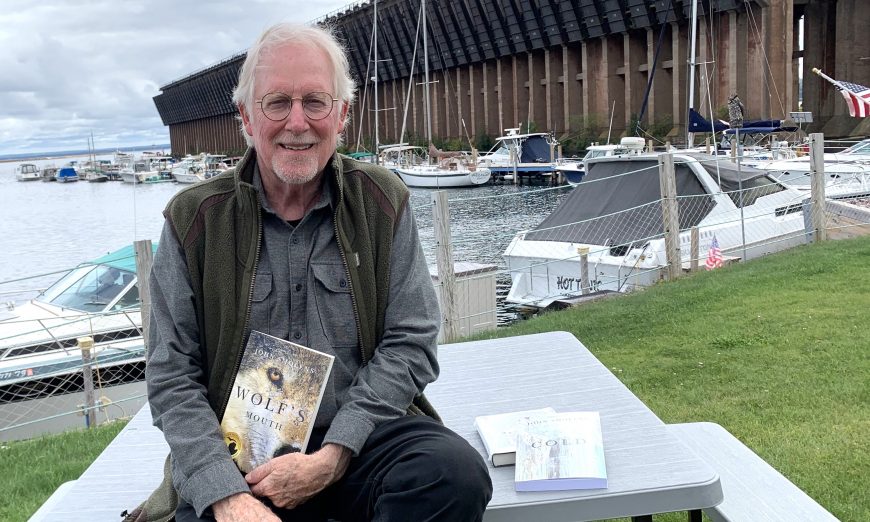“It’s unbelievable that WWII was right in our backyard, and we didn’t know it,” said Kathy Dowling from Farmington, MI, after her book club read the novel Wolf’s Mouth by Michigan writer John Smolens.
Chosen as a Library of Michigan Notable Book, Wolf’s Mouth opens in 1944 at Au Train, which was a POW camp in Michigan’s sparsely-settled Upper Peninsula (U.P.). In the novel, Smolens recounts the compelling story of fictional Italian POW Francesco Giuseppe Verdi.
Reading Wolf’s Mouth inspired Dowling to drive north to learn more about Au Train, and on an overcast September day, she was excited to meet Smolens in Marquette, the small U.P. town—near Au Train—where he has lived since 1995.
They met at his favorite Marquette restaurant, the Vierling, dating from 1883. Smolens talked about his career as the author of a dozen novels.
Au Train, originally a Civilian Conservation Corps camp, was one of five WWII POW camps in the U.P. The POWs—almost all Germans—were assigned the dangerous work of felling trees for pulpwood for 80 cents a day.
“You brought this important part of history to us!” Dowling said to Smolens.
He sat opposite her at a lunch table with a view of Lake Superior, the northernmost, biggest, deepest, and coldest of the five Great Lakes.
Living by the water is important to Smolens, who grew up near Boston. North is his favorite direction, and four of his novels are infused with the bitter winter cold of Michigan’s U.P.
WWII POW camps are a lesser-known part of Michigan—and American—history. Yet around 500 camps throughout the U.S. held some 425,000 POWs, mainly Germans, Italians, and Japanese. Michigan had 32 camps and California the most—110.
Smolens made the narrator and protagonist of Wolf’s Mouth, published by Michigan State University Press in 2016, Italian because he once lived in Italy but knew nothing firsthand of Germany. Not that he limits himself to writing about what he knows.
“I prefer to write what I can find out,” he said. “There’s nothing like going into a library and snooping around…There’s little inspiration in my case and lots of toil.”
A Cold Hard Prayer, Smolens’s twelfth novel, was released October 1. Also historically inspired, it is the story of two teenagers on an orphan train in 1924. They end up undergoing—and escaping—abuse on a Michigan farm.
There is a unique power in stories. Telling stories is probably one of the most essential ways human beings can communicate,” said Smolens, who established the Master of Fine Arts program in Creative Writing at Northern Michigan University, retiring in 2015. “By writing stories, you’re tapping into something inside [you] and connecting with the world.”
Smolens spoke of thrill and gratification when a carton of books from his publisher arrives at his house and he opens it, then lifts out his latest book, holding it in his hands for the first time—like a baby just out of the womb.
“It’s a great feeling—it never gets old—seeing the results of your labor. Hundreds of hours over the course of years devoted to one project. You’ve got to be passionate about that.”
Smolens is “toying around with” three novels-in-progress.
“Starting to write a book is the easy part,” he said. “The deeper challenge is just finishing the book…Writing is a very solitary endeavor.”
“I don’t know if I’ll live long enough to do all the stories. I have to write about an idea a while to see if it has the meat to sustain me to get to the end.”
“You may,” Smolens adds, “discover things about yourself as a writer that you would never have known had you pursued any other endeavor.”
A reader may also make discoveries.
“It’s important to know about WWII POW camps in the U.S.,” said Dowling. “I’m proud of our country for being kind to POWs.”
Related Posts:
Veterans Day War Stories
Headline: WWII Wedding Dresses Displayed At Library







There are so many thousands of interesting and unexpected stories relating to WWII. This was certainly a surprising tale. I particularly liked the end with all the local color of 1940s Detroit.
Camp Atterbury is just outside Edinburgh, Indiana in southern Indiana. My great grandparents’ farm formed part of the grounds. About 15 years ago, my aunts took me to see the Chapel of the Meadows built by the Italian and German prisoners of war. Here is the link to the information
http://www.indianamilitary.org/Camp%20Atterbury/History/history_of_camp_atterbury.htm
Really interesting reading about Camp Atterbury. Places we have never heard about but were a vital part of WWII and Korean War.